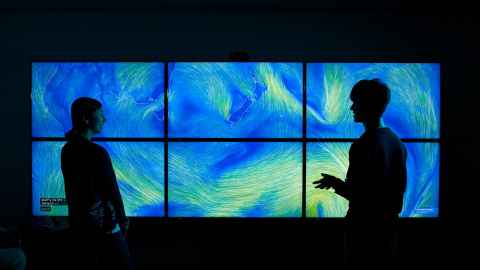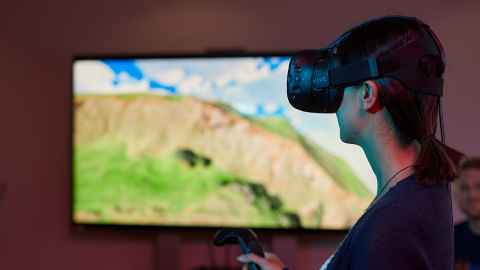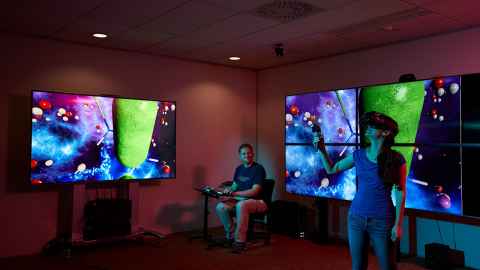Bringing education to life
3 December 2018
The current preoccupation with all things digital has amply demonstrated that many of today’s youth would rather engage with devices than with humans, so the use of Artificial Intelligence as an educational tool would appear to be a no-brainer.

Kiwi students became the first in the world to experience a digital teacher in their classroom when Vector launched an avatar called ‘Will’ – created by AI developer Soul Machines – to teach primary school students about renewable energy as part of its ‘Be Sustainable with Energy’ schools programme.
Microsoft Solutions Specialist Professional Sam McNeill believes that AI will empower schools and teachers and “provides the key to a step change for the industry”. However a conversation with University of Auckland computer scientists provides an important reality check on the digital future.
Let’s start with the avatars. There’s no doubting that Vector’s ‘Will’ captured the attention of children and encouraged engagement, but predictions that digital teachers could somehow replace humans would appear to be somewhat premature.
Department of Computer Science Associate Professor Andrew Luxton-Reilly says that predicting the future is always fraught. Back in the 1950s they were saying that because a computer could play chess there would be intelligent machines within 20 years, but 60 years later he says “we really haven’t made much progress in that direction” because machines struggle to replicate the subtlety of human behaviour.
Nevertheless, Andrew says that AI can still play an important role in general education in much the same way that the Google search engine provides basic information about a topic. “We might see some big gains in this area relatively soon without needing a machine to genuinely understand and model the knowledge that you have in the way that a human being would do it.”
The power it [virtual reality] has for showing the three or four dimensional structure or working of a scientific problem is immense.
As the Director of the Centre for eResearch, Professor Mark Gahegan believes that AI will lead to some radical changes in the education sector – over time. University research using artificial intelligence has been helpful in a variety of projects, such as modelling the erosion of beaches, due to its ability to sift and analyse complex data. “We’ve been building AI tools that perform extremely well against human based predictions made using mathematical models based on theory.”
However, a project to help hard of hearing students by translating a lecture in real time had limited success because the translation tools being used need to be re-trained for specific accents. What’s more, he says the vocabularies they draw from will need enlarging to include the technical vocabulary used in the classroom for different subjects. “Real time translation, real time mark up in lectures doesn’t work well yet, but it will. It’s just a few years away.”
One of the more tangible benefits of AI for University research is the ability to use deep learning to analyse data in real time that would have previously been prohibitive to gather and process. “We’ll learn things that we never expected to see,” says Mark. “We can analyse your every breath and heart beat and we can look for patterns in all of that, and we’re only just beginning to see how that has a really dramatic effect on what we know about ourselves. What we know about the world.”

The Centre for eResearch features a Visualisation Suite where virtual and augmented reality is being used to bring previously complex and little understood scientific issues to life. Wearing a pair of 3D glasses, it is possible to watch the Kaikoura earthquake unfold as the energy dissipated and hit Wellington within a matter of seconds. The ability to rapidly interpret complex mathematics makes it possible to diagnose a large earthquake in less than a minute, which Mark says “could leave time to get some people to safety in the wider affected area – if we had a national warning system.”
Other innovations include the use of virtual reality to teleport students into a bunch of human protein molecules where they can nudge them around and change the pH levels to see how they assemble into larger structures. “The power it has for showing the three or four-dimensional structure or working of a scientific problem is immense,” says Mark. “It can turn what is a dull textbook idea of what a protein looks like into something that’s living that you can interact with and play with which I think engages your imagination and learning and creativity far more. That’s really where we would like to be.”
Rather than simply being told about things in a university lecture, Mark believes that the technology will also allow students to discover how things work for themselves. “The part about education that is fun and engaging is discovery and that’s how we should be teaching – creating the environment where students can discover things for themselves.”
Before that can happen though, Mark says there needs to be a greater commitment to invest in immersive and augmented reality technology – like video walls, 3D projectors and sophisticated headsets – at every level of the education system. “We should be doing better in the classroom using this kind of technology.”

Like artificial intelligence, data mining and learning analytics are also likely to play an increasing role in education, especially in identifying the ‘outliers’ who might under or over perform in a classroom. “At the moment there’s not a lot of that happening,” says Andrew, “but I think we will see a lot more of that because the data science, the analysis of big data, is just exploding everywhere.”
Given the increased use in schools of digital tools such as mathematics websites, game-based activities and computerised testing, Andrew says that intelligent systems could be used to recognise patterns which determine that a person is deviating from a standard pattern and moving in a way that is known to lead to poor outcomes. “So let’s take that student and provide them with some sort of intervention that steers them back onto the right path.”
Similarly, Intelligent Tutoring Systems – which have been around since the 1980s – have had a positive impact in areas like computer programming. But, like AI, they have limitations when it comes to arts subjects which require more subjective judgements and Andrew says they are still “a long way away” from being able to achieve the so-called ‘2 sigma’ gold standard of being able to replicate a one-on-one tutor experience.
While he acknowledges that AI has a place in the classroom, as the father of two primary school children Andrew says that the majority of their classroom experiences are built around 'old fashioned' collaboration in group settings which involve talking to each other. “That’s really hard to enhance in any kind of way with any kind of artificial intelligence,” he says.
Furthermore, while digital tools might help with specific tasks there is the potential for children to lose their ability to communicate and work socially in groups or teams, which would be contrary to primary school curriculums. AI might be ideal for personalised or customised education for high or low achievers, but as far as any step change goes Andrew says “I’m less convinced that we’ll see it sweeping in and changing the way our education happens.”
inSCight
This article appears in the December 2018 edition of inSCight, the print magazine for Faculty of Science alumni.
View more articles from inSCight